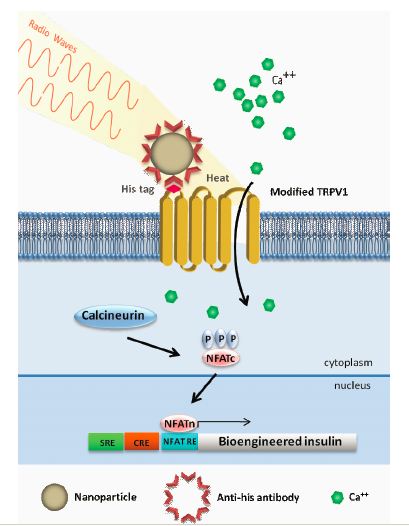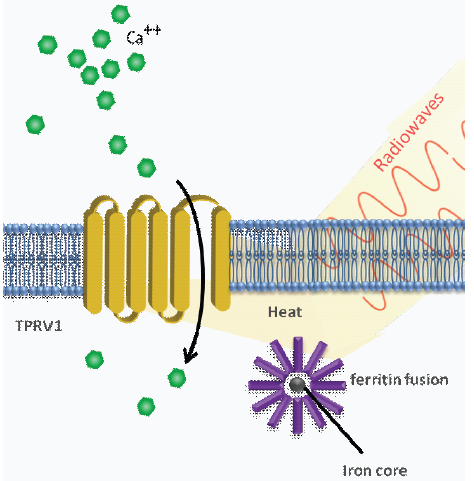Radio waves switch on genes for non-invasive treatments
May 7, 2012 | Source: Nature News

Nanoparticles induced cell excitation to increase insulin expression and release in vitro (credit: Sarah A. Stanley et al./Science)
Rockefeller University researchers have remotely activated genes inside living animals, a proof of concept that could one day lead to medical procedures in which patients’ genes are triggered on demand.
The researchers used radio waves to switch on engineered insulin-producing genes in mice.
Jeffrey Friedman, a molecular geneticist at the Rockefeller University in New York and lead author of the study, says that in the short term, the results will lead to better tools to allow scientists to manipulate cells non-invasively. But with refinement, he thinks, clinical applications could also be possible.
Friedman and his colleagues coated iron oxide nanoparticles with antibodies that bind to a modified version of the temperature-sensitive ion channel TRPV1, which sits on the surface of cells.
They injected these particles into tumors grown under the skins of mice, then used low-frequency radio waves to heat the nanoparticles. In turn, the nanoparticles heated the ion channel to its activation temperature of 42 °C. Opening the channel allowed calcium to flow into cells, triggering secondary signals that switched on an engineered calcium-sensitive gene that produces insulin.
After 30 minutes of radio-wave exposure, the mice’s insulin levels had increased and their blood sugar levels had dropped.
Precise targeting
“The great thing about this system is that radio-wave heating can penetrate deep tissue, and TRPV1 can focus that stimulus very locally to just where you have the nanoparticles,” says David Julius, a physiologist who studies TRPV1 at the University of California, San Francisco.
Friedman says that his team did not develop the method as a way of managing diabetes; insulin and blood sugar levels simply provide convenient physiological readouts for checking that the remote control is working. “There are many good treatments for diabetes that are much simpler,” he says. However, the system could potentially be engineered to produce proteins to treat other conditions.

Heating of the iron core by a radio-frequency field opens the TRPV1 channel to trigger calcium entry (credit: Sarah A. Stanley et al./Science)
In control experiments, the researchers showed that the radio waves heated only cells that contained nanoparticles, and the heat neither killed the specialized cells nor spread to neighboring, unmodified ones.
Genetic therapy
The researchers also experimented with cultured cells genetically engineered to make their own nanoparticles, and found that they could stimulate a weaker insulin secretion in these cells, too.
“What I found most novel about this is there’s no need for any chemicals or small molecules to be administered,” says Ed Boyden, an MIT neurobiologist who helped to pioneer optogenetics, a method of using fiber optics to control neural activity with light (see Robotic patch-clamping automates study of neurons).
Friedman’s current method is not practical for clinical testing because it is not ethical to grow tumors in humans, so the researchers are planning to test alternative delivery systems for the nanoparticles.
Ref.: Sarah A. Stanley et al., Radio-Wave Heating of Iron Oxide Nanoparticles Can Regulate Plasma Glucose in Mice, Science, 2012, DOI: 10.1126/science.1216753